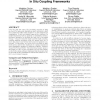Free Online Productivity Tools
i2Speak
i2Symbol
i2OCR
iTex2Img
iWeb2Print
iWeb2Shot
i2Type
iPdf2Split
iPdf2Merge
i2Bopomofo
i2Arabic
i2Style
i2Image
i2PDF
iLatex2Rtf
Sci2ools
SC
2015
ACM
2015
ACM
Lessons Learned from Building In Situ Coupling Frameworks
Over the past few years, the increasing amounts of data produced by large-scale simulations have motivated a shift from traditional offline data analysis to in situ analysis and visualization. In situ processing began as the coupling of a parallel simulation with an analysis or visualization library, motivated primarily by avoiding the high cost of accessing storage. Going beyond this simple pairwise tight coupling, complex analysis workflows today are graphs with one or more data sources and several interconnected analysis components. In this paper, we review four tools that we have developed to address the challenges of coupling simulations with visualization packages or analysis workflows: Damaris, Decaf, FlowVR and Swift. This self-critical inquiry aims to shed light not only on their potential, but most importantly on the forthcoming software challenges that these and other in situ analysis and visualization frameworks will face in order to move toward exascale. Categories and ...
| Added | 17 Apr 2016 |
| Updated | 17 Apr 2016 |
| Type | Journal |
| Year | 2015 |
| Where | SC |
| Authors | Matthieu Dorier, Matthieu Dreher, Tom Peterka, Justin M. Wozniak, Gabriel Antoniu, Bruno Raffin |
Comments (0)

